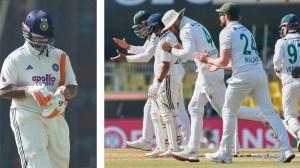Sales are up, profits will take a while
The Indian economy may be showing signs of a recovery and the stock markets heading towards a new phase of comeback, but the earnings for...

The Indian economy may be showing signs of a recovery and the stock markets heading towards a new phase of comeback, but the earnings for the first quarter suggest that the wheels of fortunes are yet to turn fully in the corporate sector. The results announced by Corporate India, barring infotech and FMCG firms, show that many industries are still trying to cope with crippling recession and falling margins.
Warns chairman of Hindustan Lever, Keki Dadiseth, while announcing the FMCG giants first-half results: “It was rural demand which has helped us to clock a record net profit but how the monsoon progresses in the next few weeks on which the rural economy depends would decide HLL’s performance in the next half.” The company posted a 24.87 per cent increase in net profit to Rs 226.79 crore in the second quarter ended June 1999.
Similarly, dental care major Colgate-Palmolive (India) Ltd announced a 42.35 per cent spurt in net profit to Rs 12 crore and a 22 per cent increase in sales to Rs 288 crore.While HLL and Colgate are rejoicing, steel producers like SAIL, Lloyds, Essar Steel and Tisco are not so fortunate.
Despite steel offtake in the first half having gone up, prices continue to languish pulling down these companies deep into red. In the first quarter, the steel industry has recorded a 254 per cent fall in net profit which is Rs 174 crore lesser than last year. “Some of the steel companies which are mismanaged would go to the BIFR fold by the end of current fiscal — irrespective of the industry picking up,” says a steel analyst with a foreign investment firm, adding: “But we expect steel prices to pick up by the end of current fiscal,” he adds.
Analysts say that first quarter performance of Indian companies are quite flat and in the coming months, a clear picture of revival, if any, would emerge. Near-recession is still prevailing in the cement industry where ACC and Larsen & Toubro are showing nascent signs of a recovery but the results of Gujarat Ambuja Cement surprised everyone. Thecompany recorded a 14 per cent jump in the net profit of Rs 150 crore for the year ended June 1999 by cutting production and manufacturing costs.
Says whole-time director Anil Singhvi: “Despite stiff competition, Gujarat Ambuja increased its market share and improved its operating margins, even as cement prices dropped sharply. This was possible by achieving high productivity and lowering the cost of production… the last quarter has been particularly satisfying as the rise in net profit was much higher than the increase in sales volumes and sales revenue.” According to a CII survey, consumer durable and non-durable sectors such as colour TVs, air conditioners, personal computers, motorcycles and medium and heavy commercial vehicles posted over 20 per cent growth in the first quarter (April-June) of 1999 over the same period of last year.
Cement, software, telecom cables and auto components were also among the 20 per cent-plus growth industries. Sectors with growth of over 10 per cent includenewsprint, electronic components, paints, processed food, pulp and paper, telecom equipment, tractors and alcoholic beverages.
On the flip side, 14 products, including nylon filament yarn, textile machinery, electric motors, tea, malted food and black and white TVs recorded a negative growth during the period. Products which witnessed negative growth include light commercial vehicles (62 per cent), cigarettes and tobacco (24 per cent), tea (17 per cent), polyester filament yarn (45 per cent) and cement (20 per cent).
Among the products which grew by over 20 per cent were telecom cables (106 per cent), colour TVs (42 per cent), followed by colour picture tube (38 per cent), hardware (30 per cent), personal computers (30 per cent) and moor cycles (31 per cent).
“The current year,” says Tata Sons chairman Ratan Tata, “is already showing signs of a revival and the automobile industry will benefit from the industrial upturn and the robust agricultural growth. We are confident about the future of thetransportation industry. Freight rates are moving up and the demand for trucks is also rising.”
One of the sectors which is showing signs of revival is the automobile industry whose sales are up 19 per cent in the first quarter while net profit of the industry has gone up by 14 per cent. The revival is led by motorcycles and small cars while scooter’s and heavy commercial vehicles’ sales are down. The two-wheelers sales are up as sales in rural areas have gone up due to a rise in demand from the rural sector. Companies like Hero Honda and Punjab Tractors, with focus products to offer to its consumers, posted a good net profit with demand coming in from the rural India.
While Reliance Industries and oil giants ONGC and Sail reported only 2-3 per cent rise in sales, ITC, Gail and MTNL recorded a decline in sales but higher net profits. However, driving the economy in the first quarter is the infotech industry which has shown a 70 per cent increase in its net profit as sales shot up by 39 per cent. Scripsof Infosys, Satyam and Pentafour are touching a new high on the BSE and Nasdaq due to expectations of a record fiscal year thanks to the Y2K projects boom.
Among the aluminium industry, Aditya Birla firm, Hindalco has reported a 10 per cent jump in its net profit to Rs 138 crore for the first quarter of the current fiscal while sales turnover during the quarter was up 14 per cent at Rs 478 crore.
Says Kumarmangalam Birla, Chairman of Aditya Birla group: “Fiscal 2000 would see higher industrial growth in India which would result in greater demand for aluminium and its downstream value-added products. Moreover, commodity prices in the international market are firming up and aluminium is no exception. Therefore, Hindalco’s sales and realisations should be even better for 1999-2000,” he said.
What has surprised the industry analysts is that the stock markets are on fire and despite various negative happenings like Kargil and elections, the BSE Sensex has gone up by 16 per cent since April this year.Predicting that the BSE Sensex might touch 6,000-point mark, HSBC Securities says: “Worst seems to be behind us, be it the Asian crisis, the domestic economy or the political situation.”
In fact, foreign institutional investors (FIIs) continued to be net buyers on Indian bourses and till August 5, FII investments have gone up to Rs 5,460.4 crore, say Securities and Exchange Board of India officials. “Post-election, the emergence of a stable government will decide the future course of Corporate India. Companies which are professionally managed and have a vision for future will perform better than others,” says a Mumbai-based analyst. No doubt, all are optimistic about a turnaround in the near future.



- 01
- 02
- 03
- 04
- 05




























